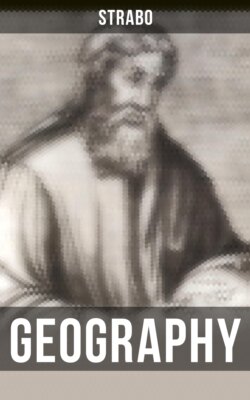Читать книгу Geography - Strabo - Страница 24
На сайте Литреса книга снята с продажи.
CHAPTER II.
ОглавлениеTable of Contents
1. We must now speak of the Aquitani and the fourteen Galatic nations pertaining to them, situated between the Garonne and the Loire, some of which extend to the river Rhone and the plains of the Narbonnaise. Generally speaking, the Aquitani may be said to differ from the Galatic race, both as to form of body and language, resembling more nearly the Iberians. They are bounded by the Garonne, and dwell between this river and the Pyrenees. There are above twenty nations which bear the name of Aquitani, small and obscure, the major part of them dwelling by the ocean, and the remainder in the interior and by the extremities of the Cevennes, as far as the Tectosages. This district, however, being too small, they added to it the territory between the Garonne and the Loire. These rivers are nearly parallel with the Pyrenees, and form with them two parallelograms, bounded on the remaining sides by the ocean and the mountains of the Cevennes.1408 Both of these rivers are navigable for a distance of about 2000 stadia.1409 The Garonne, after being augmented by three other rivers,1410 discharges itself into the [ocean] between the [country] of the Bituriges, surnamed the Vivisci,1411 and that of the Santoni;1412 both of them Gallic nations.
The Bituriges are the only foreign people who dwell among the Aquitani without forming a part of them. Their emporium is Burdegala,1413 situated on a creek formed by the outlets of the river. The Loire discharges itself between the Pictones and the Namnetæ.1414 Formerly there was an emporium on this river named Corbilon, mentioned by Polybius when speaking of the fictions of Pytheas. “The Marseillese, [says he,] when interrogated by Scipio1415 at their meeting, had nothing to tell about Britain worth mentioning, nor yet had the people of the Narbonnaise, nor those of Corbilon; notwithstanding these were the two principal cities of the district, Pytheas alone dared to forge so many lies [concerning that island].” Mediolanium1416 is the capital of the Santoni. The part of Aquitaine next the ocean is for the most part sandy and meagre, producing millet, but barren of all other fruits. Here is the gulf which, with that on the coast of Narbonne, forms the isthmus. Both these gulfs1417 go by the name of the Galatic gulf. The former gulf belongs to the Tarbelli.1418 These people possess the richest gold mines; masses of gold as big as the fist can contain, and requiring hardly any purifying, [Pg 284] [CAS. 190] being found in diggings scarcely beneath the surface of the earth, the remainder consisting of dust and lumps, which likewise require but little working. In the interior and mountainous parts [of Aquitaine] the soil is superior; for instance, in the district near the Pyrenees belonging to the Convenæ,1419 which name signifies people assembled from different countries to dwell in one place. Here is the city of Lugdunum,1420 and the hot springs of the Onesii,1421 which are most excellent for drinking. The country of the Auscii1422 likewise is fine.
2. The nations between the Garonne and the Loire annexed to the Aquitani, are the Elui,1423 who commence at the Rhone. After these the Vellæi,1424 who were formerly comprehended amongst the Arverni,1425 but now form a people to themselves. After these Arverni come the Lemovices,1426 and Petrocorii,1427 and after them the Nitiobriges,(1428) the Cadurci,(1428) and the Bituriges,(1428) surnamed Cubi. Along the ocean we meet with the Santoni, and Pictones,1428 the former dwelling by the Garonne, as we have stated, and the latter by the Loire. The Ruteni and the Gabales1429 are in the vicinity of the Narbonnaise. The Petrocorii and Bituriges-Cubi possess excellent iron-works, the Cadurci linen-factories, and the Ruteni silver-mines: the Gabales likewise possess silver-mines. On certain amongst the Aquitani the Romans have conferred the rights of Latin cities; such for instance as the Auscii, and the Convenæ.
3. The Arverni are situated along the Loire. Nemossus, their metropolis, is built on the same river.1430 This river having flowed past Genabum,1431 an emporium of the Carnutes,1432 situated about the middle of its course, discharges itself into the ocean. A great proof of the former power of the Arverni, is the fact of the frequent wars which they sustained against the Romans, sometimes with armies of 200,000 men, and sometimes with double that number, which was the amount of their force when they fought against divus Cæsar under the command of Vercingetorix.1433 Before this they had brought 200,000 men against Maximus Æmilianus, and the same number against Domitius Ænobarbus. Their battles with Cæsar took place, one in Gergovia,1434 a city of the Arverni situated on a lofty mountain, the birth-place of Vercingetorix; the other, near to Alesia,1435 a city of the Mandubii, who border on the Arverni; this city is likewise situated on a high hill, surrounded by mountains, and between two rivers. Here the war was terminated by the capture of their leader. The battle with Maximus Æmilianus was fought near the confluence of the Isère and the Rhone, at the point where the mountains of the Cevennes approach the latter river. That with Domitius was fought lower down at the confluence of the Sulgas1436 and the Rhone. The Arverni extended their dominion as far as Narbonne and the borders of Marseilles, and exercised authority over the nations as far as the Pyrenees, the ocean, and the Rhine. Luerius,1437 the father of Bituitus who fought against Maximus and Domitius, is said to have been so distinguished by his riches and luxury, that to give a proof of his opulence to his friends, he caused himself to be dragged across a plain in a car, whilst he scattered gold and silver coin in every direction for those who followed him to gather up.
